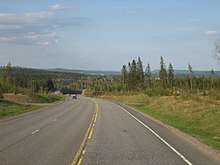Climbing lane
Climbing lanes or crawler lanes are a roadway lane design. They allow slower travel for large vehicles, such as large trucks or semi-trailer trucks, ascending a steep grade. Since climbing uphill is difficult for these vehicles, they can travel in the climbing lane without slowing traffic.
Description
Climbing lanes are a roadway lane design, typically used on major routes such as motorways and interstate highways. In the UK, the climbing lane is also referred to as a crawler lane.[1] They allow slower travel for large vehicles, such as large trucks or semi-trailer trucks, ascending a steep grade. Since climbing uphill is difficult for these vehicles, they can travel in the climbing lane without slowing traffic.
Variants
A variation that has become common with newer roads and more recent widening schemes is to add an additional "fast" (passing) lane for the stretch which otherwise would have had a crawler lane. This allows underpowered vehicles to remain in the existing "slow" lane without having to purposely pull left into the "slow" lane which drivers may not want to do because they then have to try to merge back into faster traffic (possibly still at low speed) when it ends. Instead, the more normal requirement to purposely pull out to pass slower vehicles, and back in after doing so or when the lane ends, generally with a smaller speed differential (as they will be rejoining what is already a passing lane), is placed on faster drivers.
Safety

On normally 2-lane roads without a divider, the climbing lane effectively creates a bi-directional central passing lane of the original uphill running lane. Its subsequent risk of head-on collisions, they are sometimes referred to as "suicide lanes". In some cases to reduce the risk, the road will be signed to prohibit overtaking when going downhill. Variations on this theme include altered road markings to highlight the climbing lane as being a temporary addition to the normal two (shorter dashed lines similar to those on merge/diverge lanes), or more clearly demarcating the two higher speed lanes (e.g. with markings that prevent uphill fast traffic using the downhill lane to pass slightly slower uphill vehicles themselves passing "crawlers", but still allowing downhill vehicles to overtake using the faster uphill lane if necessary, which has the effect of creating a false "center" line between the two regular lanes).
In the UK the additional climbing lane and the single downhill lane are generally separated by double white solid lines. It is an offence to position any part of your vehicle to the right of a double white line punishable by 3 penalty points, therefore this marking in itself prohibits any use of the climbing lane for overtaking by vehicles travelling downhill.
As trucks and recreational vehicles must use low gear to descend slowly, an additional lane may also be built on the downhill side. This prevents the vehicles from overusing their brakes, which may overheat and cause a runaway vehicle.
See also
References
- "The Highway Code Online". Retrieved 2008-03-02.